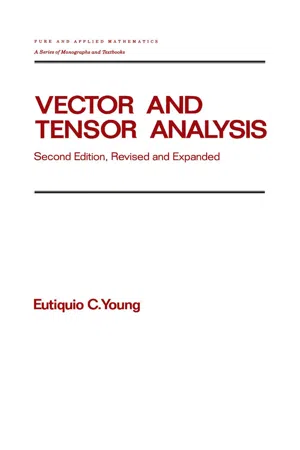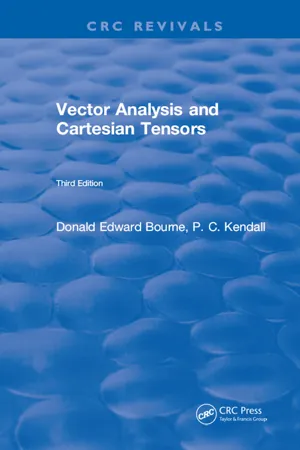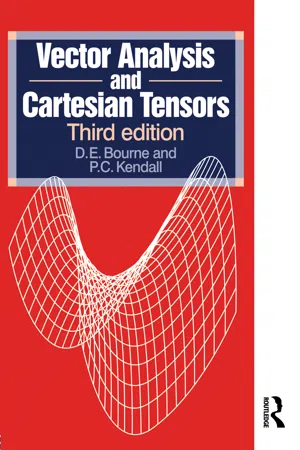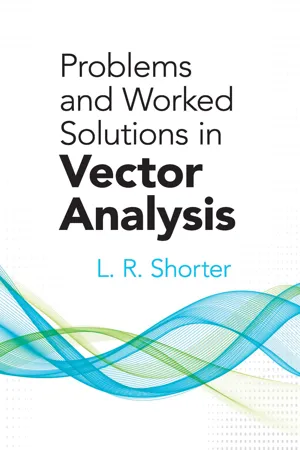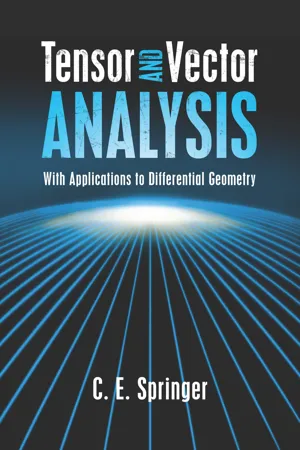Physics
Scalar and Vector
Scalars are quantities that are fully described by their magnitude, such as mass or temperature. Vectors, on the other hand, have both magnitude and direction, like velocity or force. In physics, understanding the distinction between scalars and vectors is crucial for accurately describing and analyzing physical phenomena.
Written by Perlego with AI-assistance
Related key terms
Related key terms
1 of 4
Related key terms
1 of 3
11 Key excerpts on "Scalar and Vector"
- eBook - ePub
- Eutiquio C. Young(Author)
- 2017(Publication Date)
- CRC Press(Publisher)
1VECTOR ALGEBRA1.1 Introduction
In the study of physics and engineering, we encounter many important quantities which can be described by the specification of their magnitude alone in terms of some appropriate units. For example, the volume of a cube can be described by the number of cubic inches or cubic centimeters, and the temperature at a particular time of a day can be described by giving the number of degrees on a Fahrenheit scale or a Centigrade scale. Such quantities characterized by the fact that they have magnitude only are called scalar quantities. Scalar quantities are represented by real numbers, and they are also called scalars. On the other hand, there are many other physical quantities such as displacement, force, velocity, and acceleration which cannot be described by the specification of their magnitude alone. These quantities possess not only magnitude but also direction so that a complete description of any such quantity must specify these two pieces of information. Thus when a weatherman reports the wind velocity on a particular day, he specifies not only the speed of the wind (magnitude of the wind velocity), but also the direction from which the wind is blowing. Such quantities characterized by having magnitude and direction are called vector quantities.Just as we use real numbers or scalars to represent and manipulate scalar quantities, so we use the mathematical entities called vectors to represent and manipulate vector quantities. Thus, in a sense, vectors can be thought of as generalized numbers. The study of the representation of vectors, the algebra and calculus of vectors, together with some of their various applications constitute the subject matter of vector analysis.Scalars and vectors are hardly sufficient to treat the class of quantities that are of interest in physics, engineering, and applied mathematics. In fact, there are quantities of a more complicated structure whose description requires more than knowledge of a magnitude and a direction. For example, to describe a quantity such as stress, we need to give a force (described by a vector) and a surface on which the force acts. Such a quantity can be described and represented only by the more sophisticated mathematical entity called tensor. As we shall see later, scalars and vectors are actually special cases of tensors. This is in accord with an important characteristic of mathematics in which concepts of more general nature do incorporate as particular cases those from which the concepts originated in the first place. - eBook - ePub
- Tai-Ran Hsu(Author)
- 2018(Publication Date)
- Wiley(Publisher)
direction. Examples of vectorial quantities include the velocity of an object traveling either in a (2D) plane or in a (3D) space. As well as the example of the velocity of a moving vehicle, the concept includes related quantities such as acceleration. The force acting on an object is another vectorial quantity that has to be defined in terms of its magnitude and the direction in which the force is acting. Other vectorial quantities include the electric field, current flow, and heat transmission in solids and fluids.In contrast to vectorial quantities, common physical quantities in engineering analysis such as the temperature, speed, mass of an object, heat and energy, and electric potential are scalar quantities.A vector may be represented as a directed line segment as shown in Figure 3.1 . We will use boldfaced letters and notation to designate the vector quantities throughout this book.Graphical representation of a vector.Figure 3.1In Figure 3.1 the vector A is characterized by its magnitude |A| and its direction indicated with an arrowhead. Graphical representation of this vector includes an “initial point” shown as a solid circle at one end and a “terminal point” indicated by the arrowhead. A vector with the same magnitude of vector A but acting in the opposite direction carries a negative sign (i.e., ) as also shown in Figure 3.1 .Vector quantities are usually defined by a coordinate system in engineering analyses, for example in an x–y coordinate system as shown in Figure 3.2 .Rectangular x–y coordinate system for a vector. (a) Vector A in x–y coordinates. (b) Decomposition of vector AFigure 3.2 - eBook - ePub
- A. I. Borisenko, I. E. Tarapov, Richard A. Silverman(Authors)
- 2012(Publication Date)
- Dover Publications(Publisher)
1VECTOR ALGEBRA
In this chapter we define vectors and then discuss algebraic operations on , vectors. The vector concept will be generalized in a natural way in Chapter 2, leading to the concept of a tensor. Then in Chapter 3 we will consider algebraic operations on tensors.1.1. Vectors and Scalars
Quantities which can be specified by giving just one number (positive, negative or zero) are called scalars. For example, temperature, density, mass and work are all scalars. Scalars can be compared only if they have the same physical dimensions. Two such scalars measured in the same system of units are said to be equal if they have the same magnitude (absolute value) and sign.However, one must often deal with quantities, called vectors, whose specification requires a direction as well as a numerical value. For example, displacement, velocity, acceleration, force, the moment of a force, electric field strength and dielectric polarization are all vectors. Operations on vectors obey the rules of vector algebra, to be considered below.Scalars and vectors hardly exhaust the class of quantities of interest in applied mathematics and physics. In fact, there are quantities of a more complicated structure than scalars or vectors, called tensors (of order 2 or higher), whose specification requires more than knowledge of a magnitude and a direction. For example, examination of the set of all stress vectors acting on all elements of area which can be drawn through a given point of an elastic body leads to the concept of the stress tensor (of order 2), while examination of the deformation of an arbitrary elementary volume of an elastic body leads to the concept of the deformation (or strain ) tensor. - eBook - ePub
Vector Analysis and Cartesian Tensors
Third Edition
- Donald Edward Bourne(Author)
- 2018(Publication Date)
- Chapman and Hall/CRC(Publisher)
Scalar and Vector algebra 2 2.1 SCALARSAny mathematical entity or any property of a physical system which can be represented by a single real number is called a scalar. In the case of a physical property, the single real number will be a measure of the property in some chosen units (e.g. kilogrammes, metres, seconds).Particular examples of scalars are: (i) the modulus of a complex number; (ii) mass; (iii) volume; (iv) temperature. Note that real numbers are themselves scalars.Single letters printed in italics (such as a, b, c, etc.) will be used to denote real numbers representing scalars. For convenience statements like ‘let a be a real number representing a scalar’ will be abbreviated to ‘let a be a scalar’.Equality of scalars Two scalars (measured in the same units if they are physical properties) are said to be equal if the real numbers representing them are equal.It will be assumed throughout this book that in the case of physical entities the same units are used on both sides of any equality sign.Scalar addition, subtraction, multiplication and divisionThe sum of two scalars is defined as the sum of the real numbers representing them. Similarly, scalar subtraction, multiplication and division are defined by the corresponding operations on the representative numbers. In the case of physical scalars, the operations of addition and subtraction are physically meaningful only for similar scalars such as two lengths or two masses.Some care is necessary in the matter of units. For example, if a, b are two physical scalars it is meaningful to say their sum is a + b only if the units of measurement are the same.Again, consider the equationT =giving the kinetic energy T of a particle of mass m travelling with speed v. If T has the value 30 kg m2 s−2 and v has the value 0.1 km s−1 , then to calculate m = 2T/v2 consistent units for length and time must first be introduced. Thus, converting the given speed to m s−1 we find v has the value 100 m s−1 . Hence the value of m1 2mv 2 - P C Kendall(Author)
- 2017(Publication Date)
- Routledge(Publisher)
2 Scalar and Vector algebra2.1 Scalars
Any mathematical entity or any property of a physical system which can be represented by a single real number is called a scalar . In the case of a physical property, the single real number will be a measure of the property in some chosen units (e.g. kilogrammes, metres, seconds).Particular examples of scalars are: (i) the modulus of a complex number; (ii) mass; (iii) volume; (iv) temperature. Note that real numbers are themselves scalars.Single letters printed in italics (such as a, b, c , etc.) will be used to denote real numbers representing scalars. For convenience statements like ‘let a be a real number representing a scalar’ will be abbreviated to ‘let a be a scalar’.Equality of scalars Two scalars (measured in the same units if they are physical properties) are said to be equal if the real numbers representing them are equal.It will be assumed throughout this book that in the case of physical entities the same units are used on both sides of any equality sign .Scalar addition, subtraction, multiplication and divisionThe sum of two scalars is defined as the sum of the real numbers representing them. Similarly, scalar subtraction, multiplication and division are defined by the corresponding operations on the representative numbers. In the case of physical scalars, the operations of addition and subtraction are physically meaningful only for similar scalars such as two lengths or two masses.Some care is necessary in the matter of units. For example, if a, b are two physical scalars it is meaningful to say their sum is a + b only if the units of measurement are the same.Again, consider the equationT =giving the kinetic energy T of a particle of mass m travelling with speed v . If T has the value 30 kg m2 s-2 and v has the value 0.1 km s-1 , then to calculate m -2T /v 2 consistent units for length and time must first be introduced. Thus, converting the given speed to m s-1 we find v has the value 100 m s-l . Hence the value of m1 2mv 2- eBook - ePub
Doing Physics with Scientific Notebook
A Problem Solving Approach
- Joseph Gallant(Author)
- 2012(Publication Date)
- Wiley(Publisher)
Chapter 3Vectors
In the previous chapter, we described 1-dimensional motion. We specified an object’s position along one axis as either positive or negative. All information about the direction was carried by the sign.The universe is not 1-dimensional. There are more complicated motions that require more complicated descriptions. Fortunately, there are mathematical tools called vectors that will allow us to extend our study of motion to 2 and 3 dimensions. Vectors turn a difficult 2-d problem into two easy 1-d problems. That is a good trade.Many physical quantities can be described by a single number and a unit. Room temperature is approximately 21 °C and a typical class lasts about 3600 s. These numbers are called scalars. Temperature and time are examples of scalars. Scalars obey the usual rules of arithmetic. You can punch them into your calculator or use SNB. Scalars are old friends, the numbers you’ve been using for a long time. We just gave them a new name.Sometimes scalars are inadequate. Consider the following simple example. Suppose you walk 5 m, stop, then walk another 12 m. How far from your original location are you? It depends on the direction! Where you end up depends on both how far and in which direction you walk.If you only walk in one direction, you end up 5 m + 12 m = 17 m away from your initial position. If you walk 5 m to the left and then turn around and walk 12 m to the right, you end up 12 m - 5 m = 7 m to the right of your initial position. If you walk forward 5 m, turn right and walk another 12 m, you end up 13 m away from your initial position.Such quantities are called vectors. Vectors are mathematical quantities that have magnitude and direction. The vector’s magnitude tells us how much of the physical quantity we have. As Figure 3.1 - eBook - ePub
- Michael M. Mansfield, Colm O'Sullivan(Authors)
- 2020(Publication Date)
- Wiley(Publisher)
by definition, the same as the rule for addition of displacements. Vector quantities, therefore, cannot usually be added arithmetically; different methods for adding vectors will be outlined below.4.2 Vector algebra
Representation of vectors
In printed text bold type is usually used to denote vector quantities, for example r for displacement, v for velocity, etc. (in some texts an arrow drawn above the symbol is used to denote its vector nature, for example ). In handwriting, an arrow or a line may be drawn over the symbol or a line drawn under it. To represent the vector r, the displacement of the point P with respect to O (Figure 4.6 (a)), we draw a line which is |r| units long, where |r| denotes the magnitude (the length) of the r vector, with an arrowhead in the direction from O to P to indicate the direction. In representing a vector on a page we may scale its magnitude to our convenience, for example if |r| = 2 m, we may choose to scale magnitudes in the ratio 100:1, as in Figure 4.6 (where the line representing r is 2 cm long), to allow the representation of r to fit conveniently on the page.(a) The displacement of P relative to O is represented by the vector r which gives both the magnitude and direction of the displacement of P with respect to O. (b) The vector cr is a vector parallel to r which has magnitude c times the magnitude of r.Figure 4.6The multiplication of a vector by a scalar produces a vector that is ‘scaled’ by the magnitude of the scalar. Thus, by definition, the vector cr is a vector which is parallel to the vector r and has magnitude c times the magnitude of r, that is |cr| = c|r| (for example, in Figure 4.6 (b) where c - eBook - ePub
- L.R. Shorter(Author)
- 2014(Publication Date)
- Dover Publications(Publisher)
CHAPTER I
ADDITION
[1]. Definition of a Vector.
A vector is a magnitude which can be represented by a straight line of finite length drawn in a definite direction.In the following pages the term vector will be applied both to the magnitude itself and to its representation by a finite straight line drawn in a parallel direction.Nothing is said in this definition of the point from which the vector starts—the initial point—so that we may consider the position of this point to be arbitrary.There are, then, an infinite number of vectors having the common properties of a given finite length and a given direction. Hence all vectors having the same given length and the same direction are to be considered equivalent: thus a vector from any initial point may be replaced by an equivalent vector from any other initial point. The point which terminates a vector is called its terminal point or extremity.Vectors in the text will be represented by clarendon letters, such as a, b, c, r; but when referred to in diagrams, they will be represented by large capitals in clarendon, thus AB, CD.Finite algebraical quantities in which direction is not involved are called scalar quantities or scalars: these will be represented in the text in ordinary type.Such quantities as Force, Acceleration, Velocity (when the direction of motion of the latter is taken into account), Fluid Flow in a definite direction, are examples of vectors.Among scalars are included: the temperature of a body at a given point in it; the work done by forces on a body when it is displaced by their action from one position to another; the mass of a body; an interval of time.[2]. Addition of Vectors.
The term “addition” is applied to a method of combining vectors, which is analogous to the ordinary addition of algebraical quantities, and which is familiar in the graphic composition and resolution of forces.FIG . 1.Let AB represent a vector, with initial point A and terminal point B (Fig. 1 ), and let another BC be drawn from the terminal point B of AB. The plus sign in clarendon type, +, will be employed to denote this operation. Calling the vector AB, a and the vector BC, b, the process just described is symbolised by a + b. - eBook - ePub
- Richard L. Eisenman(Author)
- 2013(Publication Date)
- Dover Publications(Publisher)
chapter III VECTOR AND SCALAR FIELDSThis chapter exploits the vector calculus of three variables. You are urged to be constantly aware of the natural generalizations of ideas from scalar calculus and of the beneficial interplay among algebraic, geometric, and physical ideas.3.1 | POINT FUNCTIONSThe terminology “vector point function” and “scalar point function” is essentially self-explanatory. By a scalar point function we mean a machine (function) into which you feed a point and out of which comes a scalar; i.e., the domain consists of points, and the range consists of scalars. By a vector point function or vector field we mean a machine which generates a vector for each point fed to it.Definitions: A vector point function or vector field or vector function of position is a relation which associates one vector with each point of a given region of space.A scalar point function or scalar field or scalar function of position is a relation which associates one scalar with each point of a given region of space.Point functions have physical, algebraic, and geometric significance. Temperature, length of radius vector, electrostatic potential, and gravitational potential are physical representations of scalar point functions. Heat flow, the radius vector, velocity of fluid particles, and the force of gravity are physical examples of vector point functions.Algebraically, the most basic scalar point functions are the coordinates which one chooses to describe a point. In a rectangular coordinate system in three dimensions, the three displacements of a point are the scalar point functions commonly designated by the three independent variables x, y, z. These three scalar point functions are so fundamental that the algebraic representation of every other point function is commonly given in terms of x, y, and z. For example, the scalar point function representing distance from the origin is written as (x2 + y2 + z2 )½ - eBook - ePub
- Jamal T. Manassah(Author)
- 2017(Publication Date)
- CRC Press(Publisher)
7 VectorsIn this chapter, we consider both finite- and infinite-dimensional vectors. Using the Dirac notation, we show that the two cases can be conceptually treated in similar fashions. Very basic results from vector calculus in 2-D are used to solve the problem of planetary motion. In the last section, the Fourier series and the expansion in Legendre polynomials are used to illustrate the expansion in particular basis functions in infinite-dimensional spaces.7.1 Vectors in Two Dimensions
A vector in 2-D is defined by its length and the angle it makes with a reference axis (usually the x -axis). This vector is represented graphically by an arrow. The tail of the arrow is called the initial point of the vector and the tip of the arrow is the terminal point. Two vectors are equal when both their length and angle with a reference axis are equal.7.1.1 Addition
The sum of two vectorsis a vector constructed graphically as follows. At the tip of the first vector, draw a vector equal to the second vector, such that its tail coincides with the tip of the first vector. The resultant vector has as its tail that of the first vector, and as its tip, the tip of the just-drawn second vector (the Parallelogram rule) (see Figure 7.1 ).u →+v →=w →The negative of a vector is that vector whose tip and tail have been exchanged from those of the vector. This leads to the conclusion that the difference of two vectors is the other diagonal in the parallelogram (Figure 7.2 ).7.1.2 Multiplication of a Vector by a Real Number
If we multiply a vectorv →by a real number k , the result is a vector whose length is k times the length ofv →, and whose direction is that ofv →if k is positive, and opposite if k is negative.FIGURE 7.1 Sum of two vectors.FIGURE 7.2 Difference of two vectors.7.1.3 Cartesian Representation
It is most convenient for a vector to be described by its projections on the x -axis and on the y -axis, respectively; these are denoted by (v 1 , v 2 ) or (vx,vy - eBook - ePub
Tensor and Vector Analysis
With Applications to Differential Geometry
- C. E. Springer(Author)
- 2013(Publication Date)
- Dover Publications(Publisher)
10Scalar and Vector Fields
10–1. Fields. A tensor has been defined as an object with a set of components which transform in a specified manner when the coordinates are changed. These components are, in general, functions of position and therefore vary from point to point in space. The totality of these sets of functions at all points of a region of space is called a tensor field. Because the covariant derivative of a tensor is a tensor, it is seen that the covariant derivative of a tensor field is a tensor field of one higher order in the co-variant indices.It has been pointed out that a tensor field of zero order is represented by a scalar point function. As a physical model for this, one may consider the scalar function as representing the temperature at any point x i of space. In general, the temperature varies from point to point in space.A tensor field of the first order is a vector field. With each coordinate system there are associated three functions of position, which may be denoted by λ i (or by λ i ). As a physical model for this, one may consider the motion of a fluid in three-space. At each point a vector with components λ i specifies the velocity of a particle of the fluid at the point. A particular kind of vector field is obtained by taking the covariant derivative of a scalar field, which is the same as the partial derivative. For instance, the vector field represented by is the gradient vector field of the scalar field . In the temperature model, are the three rates of change of the temperature function with respect to the respective x i coordinates, and are the components of the gradient vector , which will now be shown to point in the direction of the greatest rate of change of the scalar field. If a i are the components of a unit vector A, the scalar projection of on the direction of A is given by . On the surface , the function clearly does not change. The total differential of the equation of the surface gives , which means that the a i are proportional to dx i , the direction of any tangent vector to the surface, so that the scalar projection of on the surface is zero. This shows that the direction of is normal to the surface
Index pages curate the most relevant extracts from our library of academic textbooks. They’ve been created using an in-house natural language model (NLM), each adding context and meaning to key research topics.
Explore more topic indexes
Explore more topic indexes
1 of 6
Explore more topic indexes
1 of 4
